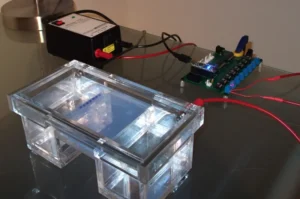
nutsvolts.com
Introduction
When the PCR reaction completes, it generates many copies of DNA, RNA, macromolecules and proteins. After completing the PCR it is necessary to check whether the plasmid has the right gene in it. Hence Gel Electrophoresis is a technique that is used in the laboratory to separate charged molecules like DNA, RNA and protein according to size. It is a technique where the same charged molecule in a mixture flow in the same direction and these molecules are separated based on size.
History
Arne Tiselius, a Swedish biochemist developed gel electrophoresis with his pioneering work. He has published his first paper on electrophoresis. The paper was “A new Apparatus for Electrophoretic Analysis of Colloidal Mixtures in 1937 and was awarded the Nobel Prize for his work in 1948. The term electrophoresis came from the Greek word “phoresis” which means “being carried”. It is referred to as the migration of charged particles in an electric field.
What Is Gel Electrophoresis
Gel electrophoresis is a ubiquitous technique used in the molecular world.
After completing the PCR reaction gel electrophoresis is carried out to separate the DNA, RNA, macromolecules and protein based on their size. An electric field pushes separated molecules through a gel containing small pores. There is an electric field in the gel electrophoresis. This electric field is applied in such a way that one end has a positive charge and the other has a negative charge. When an electric current is passed then charged molecules travel through the pores in the gel at a speed that is inverse to lengths.
In-gel electrophoresis a negatively charged molecule is pulled towards a positively charged molecule due to opposite attraction.
What Is Gel

instructables.com
There are usually two types of material are used in the gel electrophoresis:
- Agarose
- Polyacrylamide
Agarose:
The gel is a slab of jello-like material. Gels are made out of a polysaccharide which is called Agarose. Agarose is dry powdered flakes. It is a derivative of Agar. Agarose gel is made by heating Agar powder with buffer and allowed to cool, then it forms a solid and squishy gel. The gel is a matrix of agarose molecules that are held together by hydrogen bonds and produce tiny pores. Agarose gel is used for electrophoresis of both protein and nucleic acid.
Polyacrylamide:
Polyacrylamide is made by polymerization of free radical acrylamide. It consists of a chain of acrylamide monomers crosslinked with NN-methylenebisacrylamide (bisacrylamide) units. In polyacrylamide gel pore size and resolving power totally depends upon the concentration of acrylamide and bisacrylamide. This gel is ideal for the electrophoresis of protein because it has chemically inert, electrically neutral, and hydrophilic properties. It is transparent for optical detection at wavelengths greater than 250 nm.
Types Of Apparatus used in the electrophoresis:
- Vertical Gel Apparatus: Vertical gel apparatus is suitable for the SDS page for electrophoresis of protein.
- Horizontal Gel Apparatus: This apparatus is for immune electrophoresis, iso-electric focusing and electrophoresis of nucleic acid -DNA and RNA using Agarose gel.
Types of gel electrophoresis:
There are usually 4 types of gel electrophoresis:
- Agarose gel electrophoresis
- SDS-PAGE
- Pulse Field Gel Electrophoresis (PFGE)
- 2D Gel Electrophoresis
Frequently Asked Questions:
Que: What is the purpose of gel electrophoresis after PCR?
Ans: Gel electrophoresis is used to visualize the results of PCR. It is a technique in which DNA or RNA fragments are pulled through a gel matrix in an electric field and it separates DNA or RNA according to their size.
Que: Are primer used in the gel electrophoresis?
Ans: Two primers are used in the gel electrophoresis for each strand of DNA.
Que: What voltage is used in the gel electrophoresis?
Ans: 4-10V/Cm is recommended in gel electrophoresis.
Que: What affects resolution in gel electrophoresis?
Ans: The concentration of gel affects the resolution of gel electrophoresis.
Conclusion:
Gel Electrophoresis is an advanced technique to separate proteins and nucleic acid. Electrophoresis is also called Cataphoresis. It is based on the principles of charged molecules migrating under the influence of the electric field at a definite pH. field.
In the above article we have discussed the basic principles, types of gel and apparatus used in the gel electrophoresis, we will continue with the details of types of gel electrophoresis.
Disclaimer: All the content of this article is for information purposes only.
References: www.khanacademy.org

 Ribonucleic Acid (RNA): Structure, Types & Properties
Ribonucleic Acid (RNA): Structure, Types & Properties PCR: Polymerase Chain Reaction
PCR: Polymerase Chain Reaction DNA: Structure, Properties, Types
DNA: Structure, Properties, Types


